About Neck Pain – Causes & Treatment
Neck pain is a common condition that affects most of us at one time or another. Most conditions are not serious and resolve in a short time. Knowledge about neck pain can help resolve issues faster and aid in prevention of more serious conditions in the future.
Acute & Chronic Pain
Stress from poor postural habits, everyday wear and tear, disease or injury can stress the cervical spine. The neck is often prone to injury and overuse because it has a wide range of motion for turning and supporting the head. Acute pain happens suddenly and most often will resolve in in days or weeks, most often related to pain from discs, joints, ligaments or muscles. Self care methods including initial rest, ice, heat and reasonable exercise can help.
If pain continues over 3 months, it is considered chronic neck pain and, if reasonable treatment methods have not provided relief, it will most likely need special evaluation. Chronic neck pain may be present all of the time or become worse with certain motions or activities. Determining the cause can be challenging, however, factors that often are involved are degenerative conditions or arthritis, improperly healed scar tissue, nerve involvement as well as the emotional factors associated with conditions like chronic whiplash.
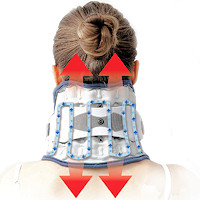 Neck Traction Devices Neck Traction Devices |
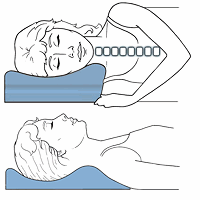 Cervical Pillows Cervical Pillows |
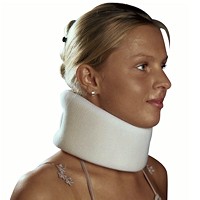 Neck Support Collars Neck Support Collars |
Structures Of The Neck
You can see the cervical spine, which is the region of the neck. The sensitive nerves and spinal cord are protected by the hard bones of the cervical spine. There are seven of these bones in the neck and are numbered from top to bottom, An example of this is C5, which C stands for cervical and 5 indicates the fifth bone. The bones are divided by discs that help absorb shock and provide smooth motion between the bones, allowing for proper distance. Nerves that come off of the spinal cord and go to parts of the body pass through openings in the bones through the neck area and into the arms. Ligaments, muscles and tendons connect the cervical spine, providing stability and motion control.
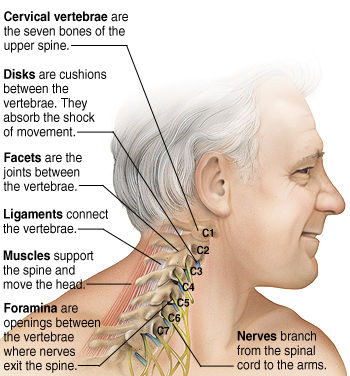
Neck Pain Symptoms
Symptoms of neck pain are often related to the structures involved. From muscles to nerves, the symptoms associated with neck involvement may include one or more of the following: tightness, stiffness, shooting, stabbing, burning, tingling or pressure. These symptoms may provide your doctor clues to the structures involved. Since the neck is a bridge between the head and shoulders, tense or sore muscles may be felt in the shoulders, neck, head, including the face. Muscles involved can present with symptoms of tightness when turning the head along with limited ability or restriction in this range of motion, often seen after a whiplash neck injury. Symptoms of nerves involved may cause tingling, weakness, numbness and pain into the shoulder, arm or hand.
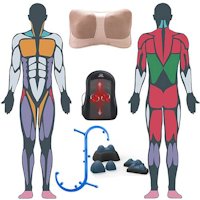 Muscle Therapy Tools Muscle Therapy Tools |
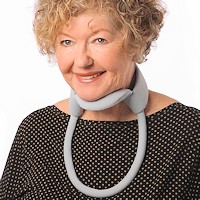 Head Supports Head Supports |
 Topical Pain Relievers Topical Pain Relievers |
Radiating Neck Pain
Usually, symptoms of pain or tingling sensations into the arms or hands are often associated with herniated cervical discs, however, muscles, joints and ligaments can also refer or send these symptoms away from the neck and into the upper limbs. Often charts showing locations of nerves are used to tell what nerve is involved, but this is not always so clear, and the most that can be said is that the location may give a clue to what segment of the cervical spine is involved, until further tests like MRI Scans can be done.
Concerning Issues
There are circumstances that neck problems need immediate medical care. If there is a fever associated with neck stiffness, meningitis should be a concern – nausea or severe headache with neck pain is also concerning. When nerve pressure is severe, symptoms of tingling, pain or numbness may extend to the legs, there can be loss of bowel or bladder control, muscle weakness and loss of coordination. If the pain is very severe and you cannot touch the chin to the chest, medical attention is needed.
About Neck Pain Causes
There are many causes for neck pain. Some of the more common causes are one or a combination of the following: natural wearing of the structures, consistent bad posture like slouching or stomach sleeping, strain from not lifting correctly, which can cause injuries normally associated with back pain. Commonly it is diagnosed as a neck strain.
Injuries are often associated with whiplash trauma, falls or sports, resulting in muscle and/or ligament tears, as well as the possibility of fractures. Discs may herniate or bulge into nerves, bone spurs from arthritis can compress or pinch nerves or cause stenosis, which is a narrowing of an opening where nerves go through, sometimes compressing the spinal cord casing cervical myelopathy, or compressing a nerve resulting in cervical radiculopathy.
Arthritis is common as we age, but there are different types; modic changes can indicate a rapid form of degeneration, some related to infection. Rheumatoid arthritis is an immune disorder causing joint destruction. Arthritis typically causes degeneration of joint protecting cartilage and causes motion restriction, inflammation causing swelling and pain.
 Special Pillows Special Pillows |
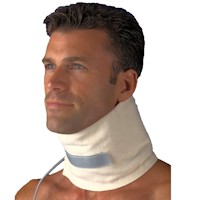 Heat Therapy Heat Therapy |
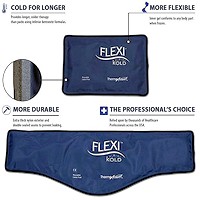 Cold Therapy Cold Therapy |
How Is Neck Pain Diagnosed?
Examination after a detailed history can include motion ranges and muscle testing including orthopedic tests which stress certain structures and neurological testing like reflexes and sensations. X-rays or other detailed imaging like MRI of the cervical spine may be done.
How Is Neck Pain Treated?
Conservative methods like self care and therapies provided by Physical Therapists and Chiropractors are done to heal the problem, restoring function and helping to prevent future problems. If these measures fail, injections or surgical procedures may be indicated.
Self care methods include resting sore areas to avoid further stress, ice for the first few days if tolerable, then heat applications and over the counter pain relievers like naproxen, ibuprofen or aspirin. These methods often cause relief within a week by reducing inflammation, relaxing muscles and easing pain. Slowly start stretching and/or mild neck exercises, because too much rest is not good.
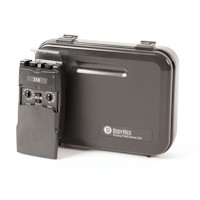 TENS Therapy TENS Therapy |
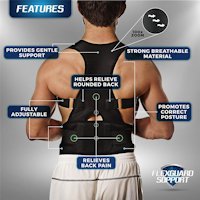 Posture Braces Posture Braces |
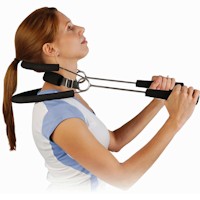 Neck Stabilization Neck Stabilization |
If the pain is not resolving in a couple days or gets worse, see a doctor. Prescription medications like muscle relaxants to alleviate spasms, analgesics to control pain or oral steroids like a Medrol dose pack can help with inflammation and swelling. Steroids may be injected into specific areas like epidural or facet injections for irritated joints, that can provide rapid relief within a 24 hour period.
Chiropractors and Physical Therapists can use manipulations, mobilization, exercises, stretches, proper lifting and ergonomics, massage, ultrasound, traction, heat and other forms of physiological therapeutics as well as recommend products for neck pain relief at home.
Usually surgery is not necessary, however, with certain emergencies, persistent muscle weakness, a disc herniation that will not resolve and cord compression, surgery may be needed and may offer the best method to resolve non responsive conditions with persisting levels of pain and dysfunction.
Recovery
Most acute neck symptoms will respond to treatment quickly and the symptoms will be alleviated within 2 weeks. Things like having a positive outlook and expecting a rapid recovery, getting back into work and life are important.
About Neck Pain Prevention
Learning simple ways to lift correctly, ergonomics including proper posture when working, sleeping and sitting, exercise and stretching, both for the neck and general fitness, nutrition, stress reduction and relaxation all play a role in preventing future neck problems.
 Ergonomic Aids Ergonomic Aids |
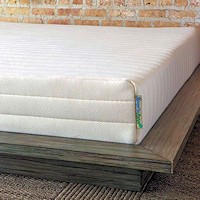 New Mattresses New Mattresses |
 Relief Supplements Relief Supplements |
A 2020 review in BMJ, one of the world’s oldest general medical journals, indicates neck pain is a serious public health problem globally. The authors indicate, “Increasing population awareness about neck pain risk factors and preventive strategies for neck pain is warranted to reduce the future burden of this condition.”
A 2021 study in the Journal of Electromyography and Kinesiology found increased muscle activity with neck pain is associated with increased postural sway and poor standing postural balance. This should be differentiated with cervical causes of dizziness.
A 2021 study in Frontiers in Pain Research found that people with neck pain are clumsy. Alterations in neck sensory input are associated with reductions in upper limb motion sense and performance. The authors of the study state, “Understanding the association between the neck and decreased accuracy of upper limb kinesthetic tasks provide pathways for treatment and rehabilitation strategies in managing clumsiness.”
